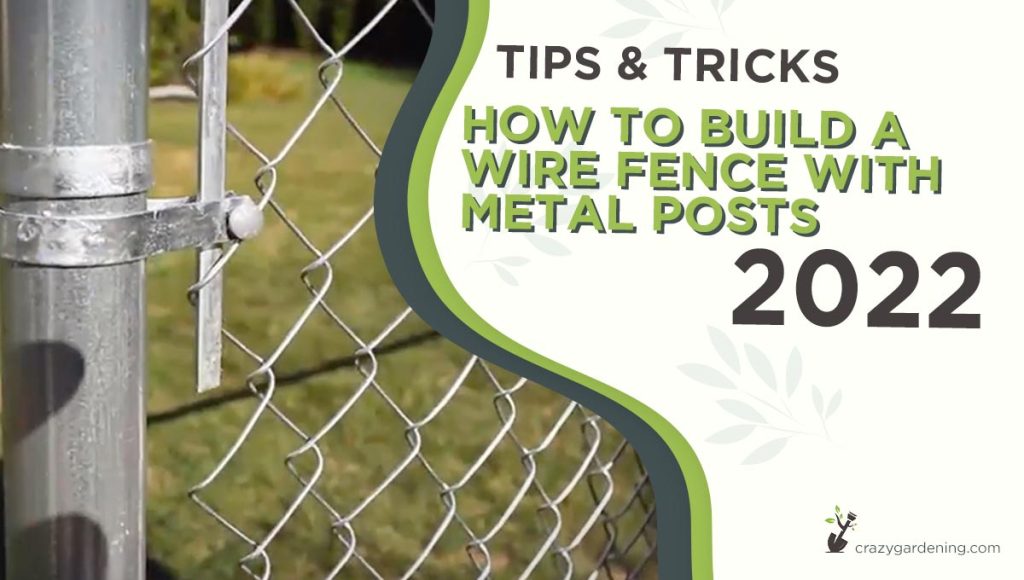Build a Wire Fence with Metal Posts [Fencing Made Easy 2025]
Do you need to build a fence for your property and garden, but don’t want to spend the money on wooden posts?
Or maybe you live in an area that is prone to wildfires and want to take precautions by building a fire-resistant fence.
Wire fences with metal posts are the best option in both of these cases, as they are not only cheaper than wood but also much more durable and long-lasting.
You can also build it in a way to keep animals out of your garden.
In either case, you can build a wire fence using metal posts. This guide will show you how you can do this and more.
Why Use Metal Posts for Wire Fences?
There are several reasons why using metal posts for wire fences is a good idea:
1. Metal posts are much cheaper than wood posts.
2. Metal posts last longer than wood posts, so you won’t have to replace them as often.
3. Metal posts are fire-resistant, so they are a good choice if you live in an area that is prone to wildfires.
4. Metal posts are easier to install than wood posts.
What Kind of Metal Posts Should You Use for a Wire Fence?
There are two types of metal posts that you can use for a wire fence: steel posts and aluminum posts.
Steel Posts
Steel posts are the stronger of the two options.
They are less likely to bend or break under the weight of the fence, and they will last longer. However, steel posts are more expensive than aluminum posts.
Aluminum Posts
Aluminum posts are not as strong as steel posts, but they are much lighter and easier to work with.
They are also less expensive than steel posts. If you are on a budget, or if you plan to install the fence yourself, aluminum posts may be the better option.
How to Build a Wire Fence?
Building a wire fence is a relatively straightforward process that can be completed in a few steps:
Planning
Before starting any fence project, it is important to determine the location of your fence, and its intended purpose.
This will help you determine the necessary length and height of the fence, the type of materials required, and the location of any gates or entrances.
Gather Materials
The materials you will need for a wire fence typically include wooden or metal posts, wire fencing, nails or screws, and any necessary tools, such as a hammer, pliers, and wire cutters.
Set the Posts
Once you have determined the location of your fence and the spacing between your posts, it is time to set your posts.
This involves digging post holes at least 2 feet deep and placing the posts into the holes, making sure they are level and secure.
It is also important to brace the corners of your fence with additional posts and cross-beams to provide extra support.
Install Wire Fencing
Once the posts are in place, the wire fencing can be attached.
Depending on the type of fence you are building, you may need to use different types of wire fencing, such as chicken wire or welded wire mesh.
Use pliers or wire cutters to cut the fencing to size, and attach it to the posts with nails or screws.
Add Finishing Touches
Once the fence is installed, you may want to add finishing touches, such as painting or staining the posts or adding a gate.
This will help to protect the wood from the elements and improve the overall appearance of the fence.

How to Build a Wire Fence with Metal Posts?
Now that you know why metal posts are the best choice for a wire fence, and what kind of metal posts to use, it’s time to learn how to install a wire fence with metal posts.
Here are the steps you need to follow:
Gather Tools and Materials
Before you begin, make sure you have all the tools and materials you will need.
You will need:
* Wire fencing
* Metal posts
* A post hole digger
* A level
* Concrete mix
* A wheelbarrow
Decide where you want to put the fence
The first thing you have to do for building a wire fence with metal posts is to decide where you want to put the fence.
You need to take into account the size of your property, as well as any obstacles that might be in the way, such as trees or buildings.
You also keep in mind the condition of the soil because you’ll need to dig holes for the posts.
Once you have a general idea of where you want to put the fence, you can start measuring and marking out the area.
Mark the location of the fence
Once you have decided where you want to put the fence, the next step is to mark the location of the fence with string or flags. This method is called “staking out the fence.”
* To do this, you’ll need to use a measuring tape to measure the distance between each post.
* Then, tie a string or flag to one end of the measuring tape, and stretch it out to the next post.
* Tie another string or flag to the end of the measuring tape, and continue until you have marked the location of all the posts.
Dig holes for the metal posts
The next step is to dig holes for the metal posts. The depth of the holes will depend on the height of the fence.
* For a 4-foot (1.2 meters) tall fence, you’ll need to dig holes that are 2 feet (60 cm) deep.
* If you’re using steel posts, the holes need to be 3 inches (7.6 cm) in diameter.
* If you’re using aluminum posts, the holes need to be 4 inches (10 cm) in diameter.
* Use a post hole digger or auger to dig the holes. If you don’t have either of these tools, you can use a shovel.
Insert the metal posts into the holes
Once the holes are dug, it’s time to insert the metal posts. If you’re using steel posts, put them into the holes and then fill the holes with concrete.
If you’re using aluminum posts, first put a piece of pipe into the hole.
This will help to protect the post from corrosion. Then, put the aluminum post into the pipe and fill the hole with concrete.
Attach the wire fence to the posts
The next step is to attach the wire fence to the posts. There are several ways to do this, but the most common method is to use wire ties.
* To do this, first, stretch the wire fence out between two posts.
* Then, tie it to the first post with a wire tie. Make sure the wire is tight so that it doesn’t sag.
* Continue tying the wire to the other posts until the whole fence is secure.
Install tension barbs
The final step is to install tension barbs. Tension barbs are used to keep the wire fence tight and prevent it from sagging.
They are also used to attach the wire fence to the posts. To install tension barbs, first, stretch the wire fence out between two posts.
Then, tie a tension barb to the first post with a wire tie. Make sure the wire is tight so that it doesn’t sag.
Continue tying the tension barbs to the other posts until the whole fence is secure.
Add any additional features, such as gates or post caps
You’ve now learned how to build a wire fence with metal posts. But there are a few more things you can do to make your fence even better.
For example, you can add gates or post caps. Gates will make it easy for you to get in and out of the fenced area, and post caps will give your fence a finished look.
By using this guide you can build a strong wire fence with metal posts in less time and money.
Types of Metal Fence Posts
Metal fence posts are a popular choice for fencing due to their durability, strength, and low maintenance.
There are several types of metal fence posts available, each with its own unique advantages and disadvantages. Here are some of the most common types:
Steel fence posts
Steel fence posts are the most popular type of metal fence posts due to their strength and durability.
They are typically galvanized, which means they are coated with a layer of zinc to prevent rust and corrosion.
Steel fence posts are available in a variety of shapes and sizes, including round, square, and rectangular.
Aluminum fence posts
Aluminum fence posts are lightweight and rust-resistant, making them an excellent choice for use in areas with high moisture or salt content in the air.
They are not as strong as steel fence posts, so they are typically used for lighter-duty fencing.
Iron fence posts
Iron fence posts are durable and strong, making them an excellent choice for heavier-duty fencing. They can be ornamental, adding a decorative touch to your fence.
Cast iron fence posts
Cast iron fence posts are similar to iron fence posts, but they are made using a casting process that creates a more intricate design. They are typically used for ornamental fencing.
T-posts
T-posts are a type of steel fence post that are shaped like a “T”. They are typically used for agricultural fencing and are easy to install and remove.
Galvanized steel fence posts
Galvanized steel fence posts are steel fence posts that have been treated with a layer of zinc to prevent rust and corrosion. They are typically used for chain link fencing.
Conclusion
Wire fences are popular for a variety of reasons, chief among them their low cost and easy installation. In this blog post, weve shown you how to build a wire fence with metal posts.
With metal posts for a wire fence, we not only make the fence more durable but also give it a better look. Metal posts make your fence more stable in bad weather and less likely to sag over time.
If you have any questions about the process or would like more information, please leave us a comment below.
FAQs
Question
How do you install metal fence posts without concrete?
Answer
There are a few ways to do this, but the most common method is to use metal post spikes. To install a metal post spike, first, drive the spike into the ground with a sledgehammer. Then, insert the metal post into the spike. Make sure the post is level and plumb, and then secure it with guy wires.
Question
How do you tie a wire fence to a post?
Answer
To tie a wire fence to a post, wrap the wire around the post and twist the ends together with pliers. Alternatively, use wire clips or U-nails to attach the wire to the post.
Question
How do you keep metal fence posts from rusting?
Answer
One way to prevent metal fence posts from rusting is to coat them with a layer of primer before installing them. Another way to prevent rust is to install the posts in an area that doesn’t get a lot of rain or snow.
Question
How long do metal fence posts last?
Answer
Metal fence posts can last for many years if they are properly installed and maintained. However, they are not immune to damage from weather or accidents. If you live in an area with severe weather, it is a good idea to check your fence posts regularly for damage.
Question
How do you attach a wire fence to a metal post?
Answer
Use fence clips or hog rings to attach the wire fence to the metal post. Secure the clips or rings around the fence and post using pliers.
Question
How do you make a metal post fence?
Answer
To make a metal post fence, first dig post holes, set metal posts in concrete, then attach fence panels or mesh to the posts using clips or brackets.
Question
How far apart are metal posts on a wire fence?
Answer
The distance between metal posts on a wire fence can vary depending on factors such as the height of the fence, type of wire, and the terrain, but typically range from 6 to 12 feet apart.
Question
What posts do you use for wire fencing?
Answer
Wooden or metal posts can be used for wire fencing. Wooden posts are commonly used for temporary fencing, while metal posts are more durable and suitable for permanent fencing.


